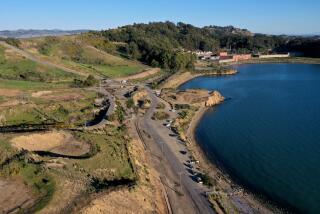Questions Raised Over Campus Seizure Efforts
- Share via
Even in the best of times, the Santa Monica Mountains Conservancy’s legal effort to seize Soka University’s historic Calabasas campus for public parkland was a quixotic quest. But Tuesday, after abandoning a three-year condemnation lawsuit against the Japanese-language school, the agency released financial records raising questions over whether the effort was ever more than a high-stakes bluff.
According to the financial summary, the conservancy and a sister agency spent nearly all the money earmarked to buy 245 acres of Soka’s oak-studded campus on other properties over the past seven years.
No month-by-month accounting was available Tuesday, but the conservancy’s executive director, Joseph T. Edmiston, acknowledged that the agency not only lacked enough cash to buy the campus but had had no prospect of receiving any more since at least the summer of 1994.
Although the conservancy never boasted of unlimited cash reserves, the disclosures about its dire financial straits were made only after it formally agreed to drop its condemnation case against Soka. In a meeting that lasted past midnight Monday, the conservancy and its sister agency, the Mountains Recreation and Conservation Authority, voted unanimously in favor of settling the bitter dispute out of court.
Under terms of the agreement, the school would donate 375 acres of open space to the conservancy and agree not to build on 35 other acres. Enrollment would be capped at 650 for 25 years and the school would agree to build only 440,000 square feet during that period.
The parks agencies really had no choice, several sources, including Edmiston, have acknowledged.
In fact, two sources said Tuesday, state and federal parks officials had doubts as early as 1992 about the conservancy’s financial ability to weather a costly court fight with Soka and then pay the school for its land, which was appraised at $19.8 million.
Edmiston and others, however, said that when the conservancy launched condemnation proceedings in 1992, it could still count on steady flows of cash from the state and federal governments to augment its small nest egg. It also planned on money from Proposition 180, a 1994 parks initiative.
But when the government taps slowed to a trickle and Proposition 180 failed at the polls, the conservancy’s careful plans were thrown into disarray. Edmiston and his staff members began scrambling to find a way out of the lawsuit.
Although the conservancy won the right to condemn Soka’s property from a judge, a jury would have decided later this year how much the school should be compensated. Had the conservancy been unable to meet the price within 30 days, Soka would not only have kept its land, but could have sued for damages.
Edmiston acknowledged Monday night that the settlement was not perfect, but compared the costly fight to the “land-use equivalent of thermonuclear war.” He said to press on with the suit would be to guarantee the “mutual assured destruction” of both the conservancy and the university’s long-term plans for its campus.
He defended spending the so-called “Soka pot” on other properties during a slide show of bucolic, conservancy-acquired sites. By taking advantage of sliding property values, Edmiston said, the conservancy cobbled together far more parkland than was possible during the height of the real estate market.
“That, what you’ve just seen, versus 650 students,” Edmiston said at the conclusion of the show.
But the display did little to mollify critics who called for an audit of the conservancy’s books and accused Edmiston of frittering away money on land considered less valuable than Soka’s, which has long been identified as a site for a visitors’ center to the Santa Monica Mountains National Recreation Area.
The private university bought the property in 1986, outbidding several public parks agencies.
“This is not a compromise,” said Les Hardie, former president of the Las Virgenes Homeowners Federation. “It’s a slow surrender.”
And Sandi Brown, an aide to state Sen. Tom Hayden (D-Santa Monica), called the settlement “absolutely without environmental justification. . . . This is a real estate deal, not a conservation decision.”
Indeed, parts of the settlement brokered by Los Angeles County Supervisor Zev Yaroslavsky and U.S. Rep. Anthony Beilenson (D-Woodland Hills) are contingent upon approval of Soka’s plans by Los Angeles County officials. For instance, if Soka’s development plans are rejected, the conservancy must pay the school’s legal costs.
Soka spokesman Jeff Ourvan said the school long suspected that the conservancy would be unable to meet a jury’s price for the campus, “but I guess even our estimates were pretty liberal.” He said while the law would have allowed the school to call the conservancy’s bluff, it was never Soka’s intent to bury the agency.
To do so would have gobbled up considerable good will in the surrounding community and among the elected officials to whom Soka must apply for development permits, Ourvan said.
“We’re very happy to see the conservancy go on its merry way and acquire parkland from willing sellers,” he said. “They were bullying us and harassing us. That’s what we wanted to stop. We didn’t want to put them out of business.”
More to Read
Sign up for Essential California
The most important California stories and recommendations in your inbox every morning.
You may occasionally receive promotional content from the Los Angeles Times.













